From the guidelines, as from January 2013"People do not need to wait for permission to log your EarthCache. Requiring someone to wait is not supported by the EarthCache guidelines. People should send their logging task answers to you, then log your EarthCache. When you review their logging task answers, if there is a problem, you should contact them to resolve it. If there is no problem, then their log simply stands."
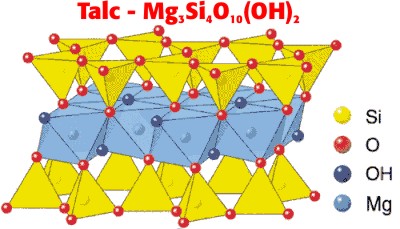

Introduction
Talc (derived from the Persian talc via Arabic talq) is a mineral composed of hydrated magnesium silicate with the empirical chemical formula Mg3Si4O10(OH)2. In loose form, it is the widely used substance known as talcum powder. It occurs as foliated to fibrous masses, its monoclinic crystals being so rare as to be almost unknown. It has a perfect basal cleavage, and the folia are non-elastic, although slightly flexible. It is sectile and very soft, with a hardness of 1 (Talc is the softest of the Mohs' scale of mineral hardness, and can be easily scratched by a fingernail). It has a specific gravity of 2.5–2.8, a clear or dusty luster, and is translucent to opaque. Talc is not soluble in water, but it is slightly soluble in dilute mineral acids. Its colour ranges from white to grey or green and it has a distinctly greasy feel. Its streak is white.
 Mineralogy and formation
Mineralogy and formation
Talc is a metamorphic mineral resulting from the metamorphism of magnesian minerals such as pyroxene, amphibole, olivine and other similar minerals in the presence of carbon dioxide and water. This is known as talc carbonation or steatization and produces a suite of rocks known as talc carbonates. It is common in ultramafic rocks, such as soapstone (a high-talc rock), and within whiteschist and blueschist metamorphic terranes.
Talc is primarily formed via hydration and carbonation of serpentine, via the following reaction;
Serpentine + Carbon Dioxide  Talc + Magnesite + Water
Talc + Magnesite + Water
Talc can also be formed via a reaction between dolomite and silica, which is typical of skarnification of dolomites via silica-flooding in contact metamorphic aureoles;
Dolomite + Silica + Water  Talc + Calcite + Carbon Dioxide
Talc + Calcite + Carbon Dioxide
Talc can also be formed from magnesian chlorite and quartz in blueschist and eclogite metamorphism via the following metamorphic reaction:
Chlorite + Quartz  Kyanite + Talc + H2O
Kyanite + Talc + H2O
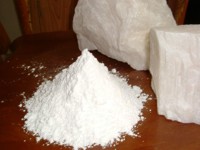 In this reaction, the ratio of talc and kyanite is dependent on aluminium content with more aluminous rocks favouring production of kyanite. This is typically associated with high-pressure, low-temperature minerals such as phengite, garnet, glaucophane within the lower blueschist facies. Such rocks are typically white, friable, and fibrous, and are known as whiteschist.
In this reaction, the ratio of talc and kyanite is dependent on aluminium content with more aluminous rocks favouring production of kyanite. This is typically associated with high-pressure, low-temperature minerals such as phengite, garnet, glaucophane within the lower blueschist facies. Such rocks are typically white, friable, and fibrous, and are known as whiteschist.
Talc is a tri-octahedral layered mineral; its structure is similar to that of pyrophyllite, but with magnesium in the octahedral sites of the composite layers.
Uses of talc
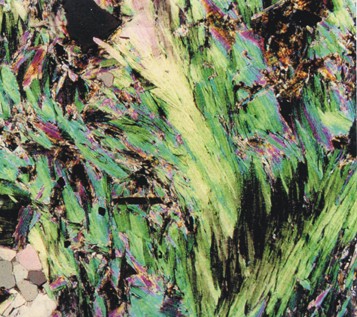 A coarse grayish-green high-talc rock is soapstone or steatite and has been used for stoves, sinks, electrical switchboards, etc. Talc finds use as a cosmetic (talcum powder), as a lubricant, and as a filler in paper manufacture. Talc is used in baby powder, an astringent powder used for preventing rashes on the area covered by a diaper. Most tailor's chalk is talc, as is the chalk often used for welding or metalworking.Talc is also used as food additive or in pharmaceutical products as a glidant. In medicine talc is used as a pleurodesis agent to prevent recurrent pneumothorax. Talc is widely used in the ceramics industry in both bodies and glazes. In low-fire artware bodies it imparts whiteness and increases thermal expansion to resist crazing. In stonewares, small percentages of talc are used to flux the body and therefore improve strength and vitrification. It is a source of MgO flux in high temperature glazes (to control melting temperature). It is also employed as a matting agent in earthenware glazes and can be used to produce magnesia mattes at high temperatures.
A coarse grayish-green high-talc rock is soapstone or steatite and has been used for stoves, sinks, electrical switchboards, etc. Talc finds use as a cosmetic (talcum powder), as a lubricant, and as a filler in paper manufacture. Talc is used in baby powder, an astringent powder used for preventing rashes on the area covered by a diaper. Most tailor's chalk is talc, as is the chalk often used for welding or metalworking.Talc is also used as food additive or in pharmaceutical products as a glidant. In medicine talc is used as a pleurodesis agent to prevent recurrent pneumothorax. Talc is widely used in the ceramics industry in both bodies and glazes. In low-fire artware bodies it imparts whiteness and increases thermal expansion to resist crazing. In stonewares, small percentages of talc are used to flux the body and therefore improve strength and vitrification. It is a source of MgO flux in high temperature glazes (to control melting temperature). It is also employed as a matting agent in earthenware glazes and can be used to produce magnesia mattes at high temperatures.
Geological setting
In northern Portugal; Castrelos - Bragança District, irregular masses of talc deposits are associated with Paleozoic ultrabasic rocks, steatised peridotite and serpentinite, which are associated with amphibolites and sericite-chlorite rich rocks of Precambrian age. The steatised peridotite and serpentinite originated talc schists and talc-tremolite schists that belong to the Soeira-nogueira Unit of the Allocthonous Ophiolite Complex.
To claim this Earthcache you have to send me the answers to the following questions:
1- Which company owns the concession?
2- What is the number of the concession?
3- Search for the talc producing talc schists and tell me what their colour is.
4- What colour is the talc?
5- At this particular location does it feel greasy to the touch?
Refs:
Robert A. Clifton, 1985. Mineral Facts and Problems
Geonovas, 1985. Revista da Associação Portuguesa de Geólogos, nº 8/9
Boletim de Minas, 1982. Publicação da Direcção Geral de Geologia e Minas, vol 19 - nº 1 - Jan/Mar
Boletim de Minas, 1993. Publicação da Direcção Geral de Geologia e Minas, 1985 a 1993

Talco – Mina de Castrelos
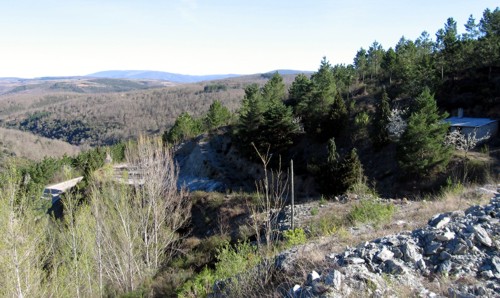 Introdução
Introdução
O talco é um mineral macio, um silicato magnesiano hidratado [formula empírica: Mg3Si4O10(OH)2], caracterizado por uma clivagem fácil e uma dureza tão baixa (1º termo da escala de Mohs) que dá a sensação de ser gorduroso ao tacto. Comercialmente o talco vai desde uma composição mineral teórica até produtos minerais com propriedades físicas em comum com o talco puro, mas que contém muito pouco do mineral actual. O termo “soapstone” (ou Pedra de Sabão) é usado para designar uma forma massiva de rocha contendo quantidades de talco até 50 %.
“Soapstone”só é usado para massas impuras de talco, enquanto para massas altamente puras se dá o nome de esteatite. Aos três minerais contendo talco; talco, “soapstone” e esteatito, normalmente designam-se somente por talco. Quando necessário trataremos da pirofilite separadamente. A pirofilite é similar ao talco em quase todas as propriedades físicas.

Historial
Soapstone foi usado pela primeira vez nos Estados Unidos pelos Índios, que cedo reconheceram o fácil que era manejar o talco e viram as suas qualidades para manter o calor, e usaram-no para vários utensílios em barro. Os primeiros europeus a instalarem-se no Norte da Carolina começaram a usá-lo para aquecer as camas, as carruagens, etc, pratica essa que durou até tempos muito recentes. Entre 1870 e 1880 muitos utensílios como tubos, banheiras, fogões, etc, eram feitos com “soapstone”. A primeira fábrica de talco foi estabelecida em Gouverneur, Nova York, por volta de 1880, e o produto foi inicialmente usado como "tapa-buracos".
Geologia
Em Portugal, os jazigos de talco ocorrem no distrito de Bragança em relação a um complexo de rochas ultrabásicas (peridotitos e serpentinitos) Paleozóicas às quais se associam rochas anfibolíticas e sericito-cloríticas de idade Pré-câmbrica.
Na localidade de Castrelos o talco ocorre em massas irregulares associadas a peridotitos e serpentinitos esteatizados que deram origem a talco-xistos e xistos talco-tremolíticos.Estas rochas enquadram-se na Unidade Soeira-Nogueira do Complexo Ofiolítico.
As reservas são razoáveis, permitindo encarar o abastecimento parcial da indústria nacional durante algumas dezenas de anos.
Para somarem mais um found têm de me enviar as respostas às seguintes perguntas:
1- Qual a companhia que detém os direitos de exploração?
2- Qual é o número da concessão mineira?
3- Procura os talco-xistos e diz-me qual a sua cor.
4- De que cor é o talco?
5- Nesta localidade o talco é gorduroso ao toque?

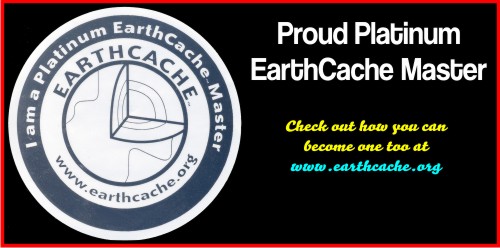
 The most exciting way to learn about the Earth and its processes is to get into the outdoors and experience it first-hand. Visiting an Earthcache is a great outdoor activity the whole family can enjoy. An Earthcache is a special place that people can visit to learn about a unique geoscience feature or aspect of our Earth. Earthcaches include a set of educational notes and the details about where to find the location (latitude and longitude). Visitors to Earthcaches can see how our planet has been shaped by geological processes, how we manage the resources and how scientists gather evidence to learn about the Earth. To find out more click HERE.
The most exciting way to learn about the Earth and its processes is to get into the outdoors and experience it first-hand. Visiting an Earthcache is a great outdoor activity the whole family can enjoy. An Earthcache is a special place that people can visit to learn about a unique geoscience feature or aspect of our Earth. Earthcaches include a set of educational notes and the details about where to find the location (latitude and longitude). Visitors to Earthcaches can see how our planet has been shaped by geological processes, how we manage the resources and how scientists gather evidence to learn about the Earth. To find out more click HERE.
